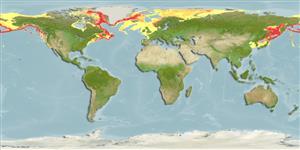>
Pleuronectiformes (Flatfishes) >
Pleuronectidae (Righteye flounders) > Hippoglossinae
Etymology: Reinhardtius: Because of Johannes Christopher H. Reinhardt, Danish zoologist, studied under Vahl and Cuvier, professor in Kobanhavn in 1813 (1776-1845) (Ref. 45335).
More on author: Walbaum.
Environment: milieu / climate zone / depth range / distribution range
Ecologia
marino benthopelagico; oceanodromo (Ref. 51243); distribuzione batimetrica 1 - 2200 m (Ref. 108960), usually 500 - 1000 m (Ref. 6263). Boreal; -1°C - 4°C (Ref. 43586); 79°N - 33°N, 180°W - 180°E (Ref. 54862)
Circumglobal: In arctic and temperate waters; northern hemisphere. Sea of Japan off Honshu north to Shishmaref, Alaska in the Chukchi Sea, throughout the Aleutian Islands, and southeast to northern Baja California, Mexico. North Atlantic: New Jersey, USA to Spitsbergen (Svalbard Islands) and the Barents Sea south to Ireland. Northwest Atlantic: Canada (Ref. 5951).
Length at first maturity / Size / Peso / Age
Maturity: Lm 63.5, range 65 - 80 cm
Max length : 110 cm TL maschio/sesso non determinato; (Ref. 80637); 130.0 cm TL (female); common length : 56.0 cm FL maschio/sesso non determinato; (Ref. 55110); peso massimo pubblicato: 7.0 kg (Ref. 173); peso massimo pubblicato: 7.0 kg; Età massima riportata: 36 anni (Ref. 117245)
Spine dorsali (totale): 0; Raggi dorsali molli (totale): 83-108; Spine anali 0; Raggi anali molli: 62 - 79; Vertebre: 60 - 64. Dorsal origin behind posterior edge of upper eye. Caudal slightly forked to truncate. Pectorals small.
Often caught pelagically (Ref. 4705). Adults prefer bottom temperatures of -0.5°C to 6.0°C (Ref. 5951). Epibenthic (Ref. 58426). Feed on crustaceans, fishes (Ref. 4705, 6885), eelpouts, capelin, redfishes, deep sea prawns and other bottom invertebrates (Ref. 35388). Batch spawner (Ref. 51846). Utilized dried or salted and frozen; can be steamed and fried (Ref. 9988). Size of the Greenland halibut collected from 400-599 m deep in eastern Bering Sea, ranged from 9 to 99 cm FL with a mean of 56 cm (Ref. 55110).
Fertilized eggs develop in approximately 50 days. Larvae are pelagic with a maximum size of 8 cm and will drift for about 4 months before settling at about 7 cm on clay-silt subtrates at depths of 300-450 m, after which they metamorphose (Ref. 117245).
Vinnikov, K.A., R.C. Thomson and T.A. Munroe, 2018. Revised classification of the righteye flounders (Teleostei: Pleuronectidae) based on multilocus phylogeny with complete taxon sampling. Molecular phylogenetics and evolution, 125:147-162. (Ref. 122998)
IUCN Red List Status (Ref. 130435)
Threat to humans
Harmless
Human uses
Pesca: elevato interesse commerciale
Strumenti
Special reports
Download XML
Fonti Internet
Estimates based on models
Preferred temperature (Ref.
123201): 0.5 - 4.2, mean 3 °C (based on 361 cells).
Phylogenetic diversity index (Ref.
82804): PD
50 = 1.0000 [Uniqueness, from 0.5 = low to 2.0 = high].
Bayesian length-weight: a=0.00363 (0.00292 - 0.00452), b=3.19 (3.12 - 3.26), in cm total length, based on LWR estimates for this species (Ref.
93245).
Trophic level (Ref.
69278): 4.4 ±0.1 se; based on diet studies.
Resilienza (Ref.
120179): Basso, tempo minimo di raddoppiamento della popolazione 4.5 - 14 anni (K=0.07-0.10; tm=7-12; tmax=30; Fec=6,800).
Prior r = 0.25, 95% CL = 0.17 - 0.38, Based on 10 stock assessments.
Fishing Vulnerability (Ref.
59153): High to very high vulnerability (71 of 100).
Climate Vulnerability (Ref.
125649): Moderate vulnerability (39 of 100).
Nutrients (Ref.
124155): Calcium = 6.69 [3.30, 13.54] mg/100g; Iron = 0.117 [0.062, 0.270] mg/100g; Protein = 15 [13, 17] %; Omega3 = 0.262 [0.104, 0.631] g/100g; Selenium = 44.6 [20.3, 101.4] μg/100g; VitaminA = 17.9 [3.9, 85.7] μg/100g; Zinc = 0.308 [0.204, 0.448] mg/100g (wet weight); based on
nutrient studies.
